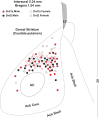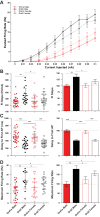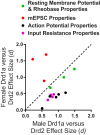Electrophysiological properties of medium spiny neurons in the nucleus accumbens core of prepubertal male and female Drd1a-tdTomato line 6 BAC transgenic mice
- PMID: 29975170
- PMCID: PMC6230806
- DOI: 10.1152/jn.00257.2018
Electrophysiological properties of medium spiny neurons in the nucleus accumbens core of prepubertal male and female Drd1a-tdTomato line 6 BAC transgenic mice
Abstract
The nucleus accumbens core (AcbC) is a striatal brain region essential for integrating motivated behavior and reward processing with premotor function. In humans and rodents, research has identified sex differences and sex steroid hormone sensitivity in AcbC-mediated behaviors, in disorders, and in rats in the electrophysiological properties of the AcbC output neuron type, the medium spiny neuron (MSN). It is unknown whether the sex differences detected in MSN electrophysiological properties extend to mice. Furthermore, MSNs come in distinct subtypes with subtle differences in electrophysiological properties, and it is unknown whether MSN subtype-specific electrophysiology varies by sex. To address these questions, we used male and female Drd1a-tdTomato line 6 bacterial artificial chromosome transgenic mice. We made acute brain slices of the AcbC, and performed whole cell patch-clamp recordings across MSN subtypes to comprehensively assess AcbC MSN subtype electrophysiological properties. We found that ( 1 mice MSNs did not exhibit the sex differences detected in rat MSNs, and 2) electrophysiological properties differed between MSN subtypes in both sexes, including rheobase, resting membrane potential, action potential properties, intrinsic excitability, input resistance in both the linear and rectified ranges, and miniature excitatory postsynaptic current properties. These findings significantly extend previous studies of MSN subtypes performed in males or animals of undetermined sex and indicate that the influence of sex upon AcbC MSN properties varies between rodent species. NEW & NOTEWORTHY This research provides the most comprehensive assessment of medium spiny neuron subtype electrophysiological properties to date in a critical brain region, the nucleus accumbens core. It additionally represents the first evaluation of whether mouse medium spiny neuron subtype electrophysiological properties differ by sex.
Keywords: medium spiny neuron; mice; nucleus accumbens; sex; ventral striatum.
Figures







Similar articles
-
Estrous cycle-induced sex differences in medium spiny neuron excitatory synaptic transmission and intrinsic excitability in adult rat nucleus accumbens core.J Neurophysiol. 2018 Sep 1;120(3):1356-1373. doi: 10.1152/jn.00263.2018. Epub 2018 Jun 27. J Neurophysiol. 2018. PMID: 29947588 Free PMC article.
-
Electrophysiological Properties of Medium Spiny Neuron Subtypes in the Caudate-Putamen of Prepubertal Male and Female Drd1a-tdTomato Line 6 BAC Transgenic Mice.eNeuro. 2019 Mar 13;6(2):ENEURO.0016-19.2019. doi: 10.1523/ENEURO.0016-19.2019. eCollection 2019 Mar-Apr. eNeuro. 2019. PMID: 30899778 Free PMC article.
-
Nucleus accumbens core medium spiny neuron electrophysiological properties and partner preference behavior in the adult male prairie vole, Microtus ochrogaster.J Neurophysiol. 2018 Apr 1;119(4):1576-1588. doi: 10.1152/jn.00737.2017. Epub 2018 Jan 17. J Neurophysiol. 2018. PMID: 29361665 Free PMC article.
-
Sex Differences in Medium Spiny Neuron Excitability and Glutamatergic Synaptic Input: Heterogeneity Across Striatal Regions and Evidence for Estradiol-Dependent Sexual Differentiation.Front Endocrinol (Lausanne). 2018 Apr 18;9:173. doi: 10.3389/fendo.2018.00173. eCollection 2018. Front Endocrinol (Lausanne). 2018. PMID: 29720962 Free PMC article. Review.
-
The estrous cycle and 17β-estradiol modulate the electrophysiological properties of rat nucleus accumbens core medium spiny neurons.J Neuroendocrinol. 2022 Jun;34(6):e13122. doi: 10.1111/jne.13122. Epub 2022 Apr 2. J Neuroendocrinol. 2022. PMID: 35365910 Free PMC article. Review.
Cited by
-
Perinatal activation of ERα and ERβ but not GPER-1 masculinizes female rat caudate-putamen medium spiny neuron electrophysiological properties.J Neurophysiol. 2021 Jun 1;125(6):2322-2338. doi: 10.1152/jn.00063.2021. Epub 2021 May 12. J Neurophysiol. 2021. PMID: 33978486 Free PMC article.
-
A nonparametric test of group distributional differences for hierarchically clustered functional data.Biometrics. 2023 Dec;79(4):3778-3791. doi: 10.1111/biom.13846. Epub 2023 Mar 13. Biometrics. 2023. PMID: 36805970 Free PMC article.
-
Cell-Type- and Endocannabinoid-Specific Synapse Connectivity in the Adult Nucleus Accumbens Core.J Neurosci. 2020 Jan 29;40(5):1028-1041. doi: 10.1523/JNEUROSCI.1100-19.2019. Epub 2019 Dec 12. J Neurosci. 2020. PMID: 31831522 Free PMC article.
-
Sex differences in membrane properties and cellular excitability of dopamine D1 receptor-expressing neurons within the shell of the nucleus accumbens of pre- and mid-adolescent mice.Biol Sex Differ. 2024 Jul 13;15(1):54. doi: 10.1186/s13293-024-00631-1. Biol Sex Differ. 2024. PMID: 39003495 Free PMC article.
-
Selective block of adenosine A2A receptors prevents ischaemic-like effects induced by oxygen and glucose deprivation in rat medium spiny neurons.Br J Pharmacol. 2022 Oct;179(20):4844-4856. doi: 10.1111/bph.15922. Epub 2022 Jul 27. Br J Pharmacol. 2022. PMID: 35817954 Free PMC article.
References
Publication types
MeSH terms
Grants and funding
LinkOut - more resources
Full Text Sources
Other Literature Sources
Research Materials
Miscellaneous

